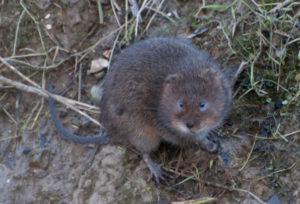Water vole: how to identify and neutralize a waterfowl rat
In order for gardeners and gardeners to protect plots from pests, they need to know how they look, how they reproduce, and how to get rid of them. The water rat lives near water, but it can destroy the crops in the garden and gnaw the bark on the trees in the garden.
Content
What does a water vole look like (photo)
Name: Water vole, European water rat
Latin: Arvicola amphibiusClass: Mammals - Mammalia
Squad: Rodents - Rodentia
Family: Hamsters - Cricetidae
 | Habitats: | garden |
 | Catering: | young shoots, roots, insects |
 | Features: | swims well and quickly, they come to people only in case of severe hunger. |
Description of the animal
The European water rat or water vole belongs to the hamster family and is the most harmful of its kind. It is distributed over most of Europe, almost throughout Russia, except for the Far East, Eastern Siberia and the Far North.
Outwardly, it looks like an ordinary rat, but it has a short muzzle with small ears. The body is oval, covered with silky long reddish-brown fur, with short legs and a long tail. Its length can be 15-25 cm, the maximum weight is about 300 grams.
The tail of this animal is noteworthy, it is covered with hair, and not naked, as in some representatives of this species. It can reach 2/3 of the entire length of the mouse itself.
There was a time when the water vole was a furry animal and its skins were highly valued. Now they are no longer used in industry, so the population has grown significantly.
Habitat
The water rat lives on the banks of rivers, lakes, ponds. The reason for its resettlement may be the spill of the waters of the reservoir or famine. Closer to autumn, she can settle in fields and gardens, and breed her offspring there.
The water vole makes its burrows in dry grass or next to beds. During the season, she is able to give birth to two to four broods, each of which can have up to 15 cubs.
In Holland, water rats cause great damage to tulip plantings in winter, eating their bulbs.
Most of the time, it's there. But high water or famine can force them to change their place of residence.
Such a situation is possible. Rats can only attack when cornered and very scared. The mother, protecting the offspring, can also go on the attack.
What harm does
The rat can eat succulent shoots, earthworms, tree bark. But especially her taste is root crops, flower bulbs.
He arranges fodder tables in burrows, drags food there, prepares for himself several kilograms of vegetables and plant rhizomes for the winter. The water rat also gnaws the bark on tree trunks.
There are several main factors that harm a person:
- The animal is constantly hyperactive, around the clock on land, in water and on trees.
- Most often, a vole settles in a colony and the whole family quickly harms the surrounding area.
- The rat does not know how to store provisions for itself, so in winter it likes to move closer to the possessions of a person, where there is something to profit from. She loves eggs and insects.
- The colony easily climbs into the vegetable store and even into the cellar, quickly destroying the stored crop.
How to recognize on the site
If there is a suspicion that a pest has started up on the site, but he has not personally met yet, you can observe the first signs.
- They leave behind the so-called fodder tables - platforms with the remains of gnawed plants and trampled paths to them.
- Molehills, traces on the surface of the ground, similar to mole pits, but asymmetrical and at different distances.
- These water rats love the young apple tree most of all, they eat its bark incredibly.

The water rat is a gluttonous neighbor.
How to get rid of an animal
To combat water rats in the garden, shallow trenches are made around the trees, into which a mixture of peat or ash with strong-smelling substances is poured. The trunk is tied with burlap or spruce branches.
Also used are folk remedies:
- rags soaked in machine oil are thrust into holes;
- pour oven soot diluted to the consistency of sour cream into holes;
- pieces of scorched rabbit skin are stuffed into holes;
- use plants with thorns that cling tightly to the skin, they fall asleep in holes.
Measures to prevent the occurrence
Rats cannot stand pungent odors, so the site can be planted with plants with strong-smelling roots, these can be various types of euphorbia, black root, imperial hazel grouse, elderberry.
A modern method is to scare away a rodent using ultrasonic means that do not interfere with the operation of home radio and television equipment and are not harmful to people and animals.
Conclusion
Although water rats cause great harm, there are effective methods of dealing with them. And in those areas where there are a lot of them, and the harm from them is significant, it is important to take care of preventive measures.
Previous

